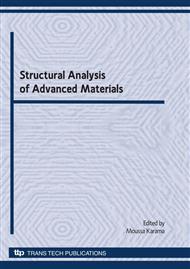[1]
Goswami S. Finite Element Modeling for the Impact Dynamic Response of Laminated Composite Stiffened Shells, Mechanical Engineering Department, National Chiao Tung University, Hisin Chu 30050, Taiwan, China.
Google Scholar
[2]
Goswami S. Geometrically Non- Linear Transient Dynamic Response of Laminated Composite Stiffened Shells, Department of Ocean Engineering and naval Architecture, Indians Institute of Technology, Kharagpur - 721302, Onest Bengale INDIA.
DOI: 10.3940/rina.icsotin.2013.17
Google Scholar
[3]
Wahab M. Study of the dynamic behaviour of sandwich plates under impact, Bordeaux, (1997).
Google Scholar
[4]
Song J., Wong H. and Belytschko T. A comparative study on finite element methods for dynamic fracture, Springer- Verlag (2007).
Google Scholar
[5]
Kevin M, Tuner A., Vizzini J. Response of Impacted Sandwich Panels With Integral Stiffeners, Journal of Sandwich Structures and Materials, 6, 313, (2004).
DOI: 10.1177/1099636204035394
Google Scholar
[6]
Vaidya A.S., Vaidya U.K., Uddin N. Impact response of three-dimensional multifunctional sandwich composite, Journal of Sandwich Structures and Materials, Materials Science and Engineering A, Volume 472, 52-58, (2008).
DOI: 10.1016/j.msea.2007.03.064
Google Scholar
[7]
Geubelle P. H. and Baylor J. S. Impact-induced delamination of composites: a 2d simulation. Composites Part B, 29B: 589-602, (1998).
DOI: 10.1016/s1359-8368(98)00013-4
Google Scholar
[8]
De Moura M. F. S. F., Conalves J. P., Marques A. T. and de Castro P. T. Prediction of compressive strength of carbon-epoxy laminates containing delaminations by using a mixedmode damage model. Composite Structures, 50: 151-157, (2000).
DOI: 10.1016/s0263-8223(00)00091-x
Google Scholar
[9]
Camanho P. P. and Davila C. G. Mixed-mode decohesion finite elements for the simulation of delamination in composite materials. Technical Memorandum-2002-211737, NASA Langley Research Center, (2002).
Google Scholar
[10]
Turon A., Davila C. G., Camanho P. P., and Costa J. An engineering solution for using coarse meshes in the simultaion of delamination with cohesive zone model. Technical Memorandum2005-213547, NASA Langley Research Center, (2005).
Google Scholar
[11]
Hamitouche L., Tarfaoui M., Vautrin A. An interface debonding law subject to viscous regularization for avoiding instability: Application to the delamination problems, Engineering Fracture Mechanics, Volume 75, Issue 10, Pages 3084-3100, (2008).
DOI: 10.1016/j.engfracmech.2007.12.014
Google Scholar
[12]
Campilho R. D. S. G., de Moura M. F. S. F. and Domingues J. J. M. S. Modelling single and double-lap repairs on composite materials. Composites Science and Technology, 65: 19481958, (2005).
DOI: 10.1016/j.compscitech.2005.04.007
Google Scholar
[13]
Reeder JR. An evaluation of mixed-mode delamination failure criteria. Technical Memorandum 1992-104210, NASA Langley Research Center, (1992).
Google Scholar


